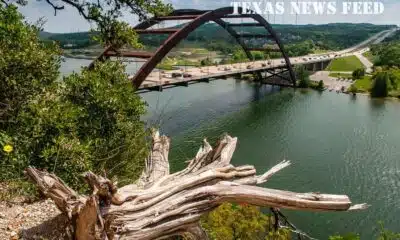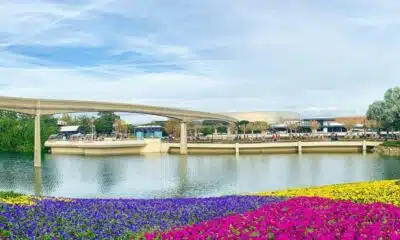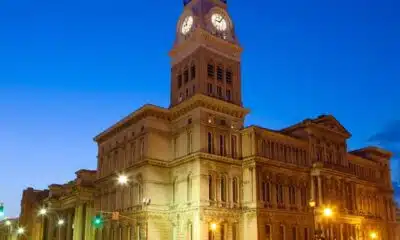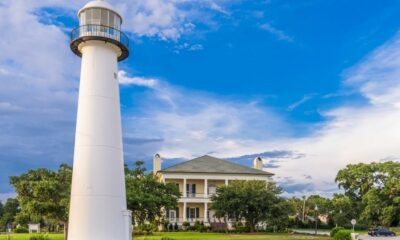News from the South - North Carolina News Feed
Buildings across NC constructed in brutalist style slowly going away
Razing concern: NC’s brutalist era is slowly ending — for better or worse
RALEIGH — Among the scores of buildings here, the city will soon lose its “ugliest.”
At least that’s the description some residents have bestowed, somewhat admiringly, upon the ill-fated Bath Building, which sits adjacent to the downtown state government complex.
This cube of concrete was constructed in 1975 to house laboratories used by the state health department. Within its walls, technicians performed a variety of procedures, from human cytology to tests for rabies and HIV.
It is an instantly recognizable work of brutalist architecture, with its blocky geometry and plain concrete exterior. Notably, there are no windows above the ground floor — a major bummer for the state employees who worked there after most of the labs moved out and were replaced by offices for unrelated departments sometime in the 2010s.
Eventually, it became vacated and scheduled for demolition. In the past year, crews have stripped the insides and removed the windows.
Sometime in March it will fall.
In reality, the Bath Building isn’t quite the visual abomination some have made it out to be. On a clear day, just before the sun sets, the western side of the building becomes masked in a golden glow. The stains and imperfections endured by 50 years of weather are washed away, and the structure stands a little prouder, its angles sharper, even in its dying days.
Perhaps that viewpoint is simply tinted by the nostalgia that comes with knowing that something will soon be gone forever.
But the Bath Building is not unique in that regard.
Buildings raised — then razed
Generations of buildings have been raised, then razed, during the slow and constant process of urban development. More than five decades after their heyday, the brutalist buildings of North Carolina now face this existential threat.
The architectural movement, once embraced especially by local and state governments in the 1970s, has a complicated legacy as the most publicly-maligned styles of building.
But when the physical legacy of the brutalist movement is torn down, what goes with it?
With a unique history as a hotbed for modern architecture in the American South, North Carolina is a fascinating place to explore that question.
City Hall in Greensboro.
The 129 West Trade building in Charlotte.
A collection of government office buildings surrounding Halifax Mall in Raleigh.
They’re all prime examples of brutalism.
Raw concrete, or béton brut in French, is the etymological origin of the term.
As one might guess, the buildings of this style were typically constructed using the material from which it gets its name. Raw concrete differs from finished concrete in that it keeps all the blemishes imprinted during the casting process.
Brutalist buildings often are modular and might take on the appearance of stacked blocks. They are rarely any other color than gray. The interiors of these buildings typically feature expansive open space and may have purposefully exposed pipes and wiring.
But … why? Is there any real purpose to this unsightly aesthetic?
A brutalist beginning
Yes, argues Burak Erdim, an N.C. State architecture professor. His research at the College of Design focuses on the history of modernity (a fascinatingly oxymoronic topic) and urbanism.
Brutalism emerged in Europe, particularly England, following the devastation from World War II. Not only was it cheap and practical, the style also represented the type of society Western nations hoped would rise out of the ruins of war.
“Postwar England, as well as many non-aligned Third World and decolonizing nations, (used brutalism) to convey their aspirations towards building a more democratic state and society through this expression of honest use of materials and associated a kind of morality with this use of rawness,” Erdim explained to Carolina Public Press. “In a similar vein, many federal, state and city governments in the United States also adopted this style to convey symbols of transparency, honesty and even thrift.”
Brutalism was just one offshoot of the expansive collection of architectural styles that, together, are referred to as modern architecture. It has become a pejorative term often misused by the general public to describe any building made of concrete that they deem an eyesore.
Ironically, the brutalist style was intended to be a shift away from a similar style that it’s often confused with. International architecture uses much of the same material palette as brutalism, but came to be associated with “American corporate power, consumerism and neo-colonialism,” Erdim said.
The brutalist style took root in America during the 1950s and remained popular through the mid-1970s, primarily with government buildings and university campuses. Its strongest influence was in the northeast, but eventually its influence trickled south and crossed over the Mason-Dixon line.
An urban legend is born
Paul Rudolph, who chaired Yale’s Department of Architecture, was perhaps America’s finest practitioner of the style. His government offices in Boston and campus buildings in New Haven made brutalism a staple of the New England urban landscape.
But one of his most ambitious works was erected in none other than Research Triangle Park near Raleigh.
The Elion-Hitchings Building, completed in 1972, was a brutalist behemoth built to be the U.S. headquarters of London-based pharmaceutical company Burroughs Wellcome. Its large size — 300,000 square feet to be exact — and unique aesthetic helped establish the Research Triangle as a nationally-renowned technology hub.
The growth of Charlotte into a banking center and the establishment of N.C. State’s College of Design in 1948 — led by visionary architect Henry Kamphoefner — further modernized North Carolina’s cityscapes.
As Erdim described it, Kamphoefner brought a “Noah’s Ark” of colleagues with him from Oklahoma University to the new design school in Raleigh to be a part of the inaugural faculty. He brought them not only to teach, but to build.
And build they did.
Buildings lost in translation
Eduardo Catalano designed Greensboro’s City Hall. Matthew Nowicki devised the plans for the striking Dorton Arena on the State Fairgrounds in Raleigh. George Matsumoto created offices for IBM in Winston-Salem.
The original design school faculty were responsible for a great number of modern residences in the growing Raleigh suburbs. Others served as consultants for numerous construction projects at the state government complex in downtown Raleigh, which included the Bath Building.
Kamphoefner’s tenure as dean at the College of Design, which lasted from 1948 to 1972, coincided neatly with a golden age of modernist architecture in the United States.

By the time he retired, the brutalist buildings of North Carolina had become less of a novelty and more of a fixture of the built environment. But along with that familiarity came more criticism from the masses.
“The symbolisms of honesty, transparency and thrift that these buildings were supposed to convey never really communicated accurately to the general public,” Erdim said.
That disconnect may have not only been for aesthetic reasons, but also cultural ones. To some, the buildings seemed imposing, authoritative and even lavish.
“They became associated with notions of big government or at least an interventionist state,” Erdim explained.
History in the breaking
By the turn of the millennium, modernist buildings across the country started to be torn down.
In 2006, the old Raleigh Civic Center — a massive concrete venue designed by A.G. Odell, one of North Carolina’s most prolific architects — was leveled.
The Elion-Hitchings Building, Rudolph’s brutalist masterwork at Research Triangle Park — was demolished in 2021 despite an outcry.
Without comprehensive records, it’s difficult to say how many lesser-known brutalist works came down in the 15 years between the death of those buildings.
Over the years, many older buildings that were built using raw concrete began to show their age. Their exteriors became stained by rain and dirt. Some literally began to crumble — consequences of their cheap construction material.
The cost of maintenance was too much compared to the price of building something new.
Another reason for these buildings’ lack of staying power was their overcommitment to specific functions, Erdim said.
“Form follows function,” is a cliché inherent to the brutalist ethic. It means that the form of a building should mirror its intended purpose. In other words, a bank should look like a bank, a library like a library and so on.
That was the story of the Bath Building. When the state laboratories were removed, its form was no longer in harmony with its function.
“When a building is too closely wrapped around a particular function, it can ultimately make it very difficult to then allow that building to house another function,” Erdim said.
So, with everything we know now, is it safe to call the brutalist movement a failure?
That question gave Erdim pause.
Then he countered: “What is successful? Maybe, in telling the truth, it was successful by trying not to be pleasing. Maybe it succeeded.”
This article first appeared on Carolina Public Press and is republished here under a Creative Commons license.
The post Buildings across NC constructed in brutalist style slowly going away appeared first on carolinapublicpress.org
News from the South - North Carolina News Feed
White House officials hold prayer vigil for Charlie Kirk
SUMMARY: Republican lawmakers, conservative leaders, and Trump administration officials held a prayer vigil and memorial at the Kennedy Center honoring slain activist Charlie Kirk, founder of Turning Point USA. Kirk was killed in Utah, where memorials continue at Utah Valley University and Turning Point USA’s headquarters. Police say 22-year-old Tyler Robinson turned himself in but has not confessed or cooperated. Robinson’s roommate, his boyfriend who is transitioning, is cooperating with authorities. Investigators are examining messages Robinson allegedly sent on Discord joking about the shooting. Robinson faces charges including aggravated murder, obstruction of justice, and felony firearm discharge.
White House officials and Republican lawmakers gathered at the Kennedy Center at 6 p.m. to hold a prayer vigil in remembrance of conservative activist Charlie Kirk.
https://abc11.com/us-world/
Download: https://abc11.com/apps/
Like us on Facebook: https://www.facebook.com/ABC11/
Instagram: https://www.instagram.com/abc11_wtvd/
Threads: https://www.threads.net/@abc11_wtvd
TIKTOK: https://www.tiktok.com/@abc11_eyewitnessnews
News from the South - North Carolina News Feed
Family, friends hold candlelight vigil in honor of Giovanni Pelletier
SUMMARY: Family and friends held a candlelight vigil in Apex to honor Giovanni Pelletier, a Fuquay Varina High School graduate whose body was found last month in a Florida retention pond. Giovanni went missing while visiting family, after reportedly acting erratically and leaving his cousins’ car. Loved ones remembered his infectious smile, laughter, and loyal friendship, expressing how deeply he impacted their lives. His mother shared the family’s ongoing grief and search for answers as authorities continue investigating his death. Despite the sadness, the community’s support has provided comfort. A celebration of life mass is planned in Apex to further commemorate Giovanni’s memory.
“It’s good to know how loved someone is in their community.”
More: https://abc11.com/post/giovanni-pelletier-family-friends-hold-candlelight-vigil-honor-wake-teen-found-dead-florida/17811995/
Download: https://abc11.com/apps/
Like us on Facebook: https://www.facebook.com/ABC11/
Instagram: https://www.instagram.com/abc11_wtvd/
Threads: https://www.threads.net/@abc11_wtvd
TIKTOK: https://www.tiktok.com/@abc11_eyewitnessnews
News from the South - North Carolina News Feed
NC Courage wins 2-1 against Angel City FC
SUMMARY: The North Carolina Courage defeated Angel City FC 2-1 in Cary, ending their unbeaten streak. Monaca scored early at the 6th minute, followed by Bull City native Brianna Pinto’s goal at the 18th minute, securing a 2-0 halftime lead. Angel City intensified in the second half, scoring in the 88th minute, but the Courage held firm defensively to claim victory. Pinto expressed pride in the win, emphasizing the team’s unity and playoff ambitions. Nearly 8,000 fans attended. Coverage continues tonight at 11, alongside college football updates, including the Tar Heels vs. Richmond game live from Chapel Hill.
Saturday’s win was crucial for the Courage as the regular season starts to wind down.
https://abc11.com/post/north-carolina-courage-wins-2-1-angel-city-fc/17810234/
Download: https://abc11.com/apps/
Like us on Facebook: https://www.facebook.com/ABC11/
Instagram: https://www.instagram.com/abc11_wtvd/
Threads: https://www.threads.net/@abc11_wtvd
TIKTOK: https://www.tiktok.com/@abc11_eyewitnessnews
-
News from the South - Kentucky News Feed7 days ago
Lexington man accused of carjacking, firing gun during police chase faces federal firearm charge
-
News from the South - Alabama News Feed7 days ago
Zaxby's Player of the Week: Dylan Jackson, Vigor WR
-
News from the South - Arkansas News Feed7 days ago
Arkansas medical marijuana sales on pace for record year
-
News from the South - North Carolina News Feed5 days ago
What we know about Charlie Kirk shooting suspect, how he was caught
-
Local News7 days ago
US stocks inch to more records as inflation slows and Oracle soars
-
Local News6 days ago
Russian drone incursion in Poland prompts NATO leaders to take stock of bigger threats
-
Local News Video6 days ago
Introducing our WXXV Student Athlete of the Week, St. Patrick’s Parker Talley!
-
News from the South - North Carolina News Feed5 days ago
Federal hate crime charge sought in Charlotte stabbing | North Carolina














































